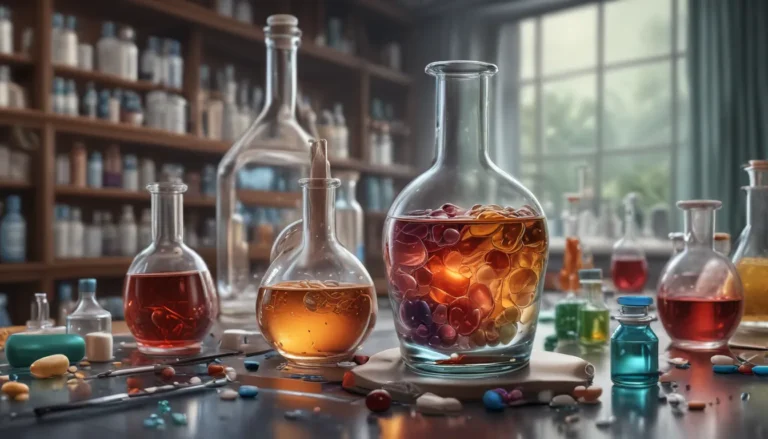A Note About Images: The images used in our articles are for illustration purposes only and may not exactly match the content. They are meant to engage readers, but the text should be relied upon for accurate information.
Are you intrigued by the wonders of anabolism and its significance in the realm of chemistry? Anabolism, a fundamental process vital for sustaining life, delves into the intricate mechanisms behind the creation and maintenance of complex molecules within living organisms. In this informative piece, we will venture into 11 extraordinary facts about anabolism that will enrich your understanding of chemistry and shed light on the beautiful complexities of our bodies.
Unraveling the Essence of Anabolism
Anabolism serves as the body’s construction crew, tirelessly building and repairing tissues and organs. Fueled by nutrients and hormones, this essential process plays a pivotal role in growth, repair, and recovery, akin to a balanced diet and exercise regimen that nurtures our bodies’ overall well-being.
The Art of Molecule Building
At the heart of anabolism lies the profound process of building new molecules within the body. From the synthesis of proteins to the formation of carbohydrates and lipids, this intricate pathway requires energy in the form of ATP to create essential building blocks crucial for biological functions.
Nutrients as Fuel for Anabolism
The consumption of nutrients serves as the fuel that drives anabolism forward. Amino acids, glucose, and fatty acids derived from our diet are diligently utilized to craft new molecules and replenish energy reserves, supporting the body’s growth and maintenance.
The Power of Protein Synthesis
Protein synthesis stands as a cornerstone of anabolic processes, essential for muscle growth, enzyme production, and immune system regulation. Through converting amino acids into proteins, the body fosters tissue repair and fortification.
Harmonizing Hormonal Regulation
Anabolic processes are overseen by a symphony of hormones such as insulin, growth hormone, and testosterone. These regulatory messengers orchestrate nutrient uptake, protein synthesis, and muscle growth, ensuring the body’s resources are aptly allocated for tissue maintenance.
The Impact of Exercise on Anabolism
Engaging in physical exercise, particularly resistance training, ignites anabolic processes within the body. By stimulating muscle protein synthesis, exercise fosters muscle growth, strength enhancement, and overall well-being.
The Role of Anabolic Steroids
While anabolic steroids can artificially augment anabolism by mimicking testosterone’s effects, their usage harbors significant health risks and is strictly prohibited without a prescription. It is crucial to prioritize natural methods of enhancing anabolism over synthetic substances.
Nurturing Growth and Recovery
Anabolism thrives during periods of growth and development, aiding in the repair of damaged tissues caused by injury or illness. By facilitating the replacement of damaged cells and tissues, anabolic processes promote healing and rejuvenation.
The Interplay of Anabolism and Catabolism
Anabolism dances in harmony with catabolism, the process of breaking down molecules to release energy. This delicate balance, known as metabolic equilibrium, ensures the body functions optimally by facilitating the building and breakdown of essential molecules.
Revitalizing After Intense Exercise
Following vigorous physical exertion, anabolism springs into action to repair damaged muscle fibers and replenish energy reserves. By promoting muscle growth, reducing injury risks, and enhancing performance, anabolic processes play a pivotal role in post-exercise recovery.
Cultivating Well-Being Through Anabolism
Anabolism’s profound impact extends beyond mere muscle and tissue growth, laying the foundation for overall health and vitality. From supporting hormone production to DNA replication and cellular maintenance, anabolism plays a multifaceted role in sustaining life.
Embracing Anabolism: A Journey to Optimal Health
In conclusion, anabolism stands as a captivating and indispensable process that underpins the functionality of living organisms. Unveiling the extraordinary facts surrounding anabolism enriches our comprehension of bodily functions and paves the way for advancements in fields such as medicine and nutrition. By harnessing the potential of anabolic processes, we can strive towards optimizing our health, enhancing athletic performance, and combating diseases.
FAQs: Exploring Anabolism Further
- What is anabolism, and how does it differ from catabolism?
- How does anabolism contribute to muscle growth?
- Can diet and exercise influence anabolic processes?
- What are the risks associated with anabolic steroid use?
- How does anabolism play a role in tissue repair?
- Is anabolism relevant to plant biology?
- How is anabolism regulated within the body?
- What disruptions can affect anabolism?
- Is anabolism solely linked to muscle and tissue growth?
Unravel the realms of anabolism, delve into the intricacies of performance-enhancing substances, and explore the natural alternatives that empower your journey towards well-being. Understanding anabolism and its interconnected topics equips you with the knowledge to make informed decisions regarding your health and vitality.
Conclusion: Embracing the Grandeur of Anabolism
Anabolism’s extraordinary facts illuminate the profound mechanisms through which our bodies build and maintain tissues, fostering growth and rejuvenation. As we navigate the realms of anabolism and its related subjects, we empower ourselves to make enlightened choices that nurture our health and vitality, guiding us towards a path of holistic well-being and resilience.
Let the wonders of anabolism inspire you to embark on a journey towards optimal health, embracing the transformative power of nature’s intrinsic building blocks.
Resources
- function()%7Bvar%20e=document.createElement('script');e.setAttribute('type','text/javascript');e.setAttribute('charset','UTF-8');e.setAttribute('src','//assets.pinterest.com/js/pinmarklet.js?r='+Math.random()*99999999);document.body.appendChild(e)%7D)([↩]





